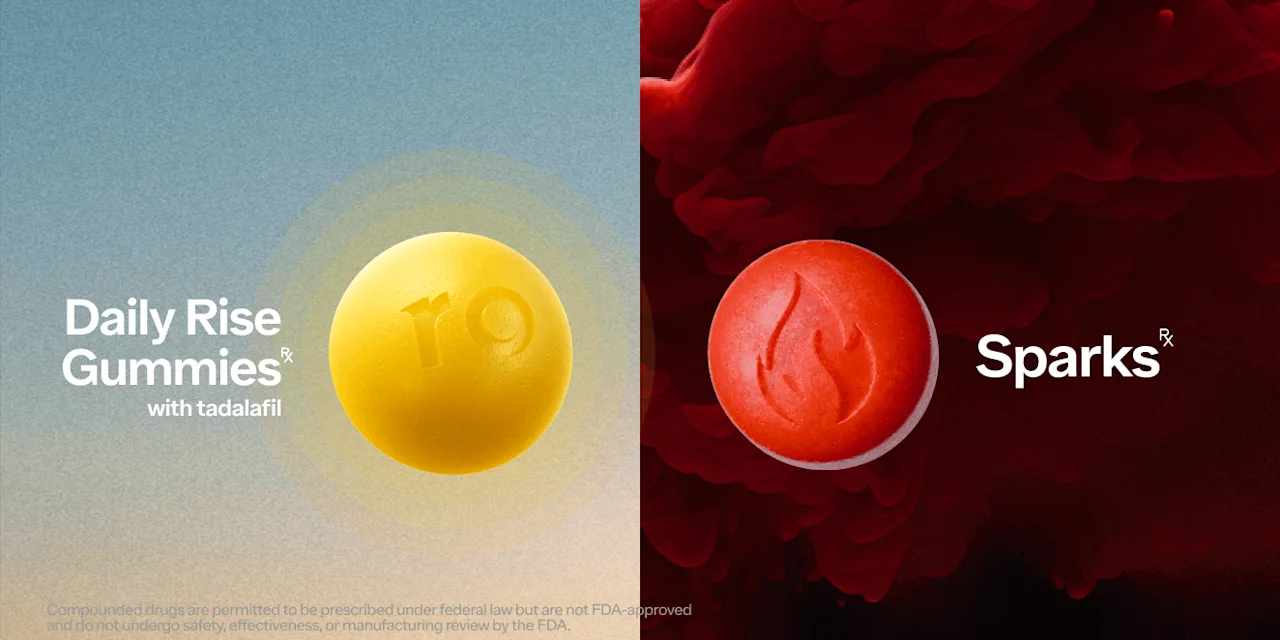Here's what we'll cover
Here's what we'll cover
Cialis is a medication primarily used to treat erectile dysfunction in men, but if you’re a woman dealing with sexual challenges, you may be wondering: Is Cialis for women a possibility? At this time, Cialis is not approved for use in women by the US Food and Drug Administration (FDA) (DailyMed, 2022). It does, however, show some promise in treating sexual dysfunction in women, so some healthcare providers will prescribe it off-label for this purpose.
Here’s what you should know about Cialis for women, including whether it works, what to know in general about sexual dysfunction in women, and what other treatment options are available.
What is Cialis?
Cialis (tadalafil) is an FDA-approved medication mainly used to treat erectile dysfunction (ED). It’s also approved to treat benign prostatic hyperplasia (BPH, enlargement of the prostate) (DailyMed, 2022).
For ED, Cialis works by increasing blood flow to the penis. To get and maintain an erection, blood vessels in the penis need to widen and fill with blood. When a person has erectile dysfunction, they may have trouble getting adequate blood flow to the penis, or their blood vessels may not widen enough. Cialis addresses both of those issues.
Cialis Important Safety Information: Read more about serious warnings and safety info.
Does Cialis work for women?
As of now, there is no female Cialis—the FDA has only approved the medication for men. However, just like there is an off-label use of Viagra (sildenafil) for women, some healthcare providers may suggest Cialis if you are struggling with female sexual dysfunction.
Similar to Cialis for men, researchers think tadalafil may increase blood flow to the genital area in women. However, female sexual dysfunction (FSD) is complex. It involves psychological, social, and physical components. As such, it’s unclear if Cialis would address aspects of FSD like sexual desire, arousal, or physical barriers to sexual satisfaction caused by aging or other medical conditions (Borghi, 2017).
The research on Cialis for women is minimal, with few large-scale studies looking at how Cialis affects sexual function in women. Here’s what we know so far about the use of Cialis in women:
A 2017 study found that daily treatment with a low dose of tadalafil was effective in treating overactive bladder in women (Chen, 2017).
In women who take antidepressants and report sexual side effects, a 20 mg dose of tadalafil has the potential to reduce sexual problems, according to a very small study from 2006 (Ashton, 2006).
A small study from 2012 found that a daily tadalafil dose of 5 mg improved sexual dysfunction in women with type 1 diabetes (Caruso, 2012).
A 2017 review of sexual dysfunction treatments in menopausal women speculated that tadalafil could successfully treat sexual conditions in postmenopausal women (Borghi, 2017)
Although the research is currently limited, using Cialis for women is certainly of interest, and more trials are underway to study the efficacy of using Cialis to treat female sexual dysfunction (NLM, 2022).
What is female sexual dysfunction?
If you’ve experienced sexual problems, you are not alone. Female sexual dysfunction (FSD) is a challenge faced by 20–40% of the female population. FSD may be experienced by premenopausal women and postmenopausal women alike, and can have physical, psychological, or social causes (Thomas, 2018).
FSD is defined as any type of sexual concern relating to (Kershaw, 2022):
Sexual arousal
Sexual desire, including low sex drive
Sexual response to any type of sexual stimulation
Ability to reach orgasm
Reduced sexual performance
Pain with sexual activity or intercourse
Decreased arousal as a side effect of a medication
The components that lead to a positive sexual experience for women are complex, which is why medications like female Viagra or Cialis for women may not solve issues relating to sexual dysfunction for every woman.
Sometimes FSD is caused by physical dysfunction, such as pelvic organ prolapse or endometriosis. Other times, it may be related to psychological issues, like depression, anxiety, or relationship issues (Kershaw, 2022).
FSD is more common in women after menopause, as decreased levels of estrogen can often cause low sexual desire. The change in hormonal makeup that happens during menopause may also increase vaginal dryness or decrease vaginal lubrication, which can reduce sexual desire and cause pain during sex (Kershaw, 2022; Borghi, 2017).
Who shouldn’t take Cialis?
At this time, Cialis is only approved by the FDA for men with erectile dysfunction or an enlarged prostate. It’s not indicated for use in women or children (DailyMed, 2022).
There has been no testing on Cialis in pregnant people, so it’s unclear whether it could cause harm to a fetus. It’s also unclear whether Cialis would be excreted in breast milk, so breastfeeding parents should not use Cialis (DailyMed, 2022).
Other groups who should not take Cialis, according to the FDA, include (DailyMed, 2022):
People with certain heart conditions or low blood pressure issues
People who take nitrate medications
Before taking Cialis, you should discuss any medications you are taking with your healthcare provider. Cialis may not be recommended in people who take alpha-blockers or blood pressure medications (DailyMed, 2022).
Other treatments for female sexual arousal disorder
Understanding what is causing a woman’s FSD is the key to treating it properly. Often, providers who treat FSD take a holistic approach, addressing any psychological concerns, interpersonal issues, as well as physical or medical conditions.
Psychological and interpersonal issues can be addressed through psychotherapy or sex therapy. Couples therapy can be helpful when it comes to improving communication about sexual preferences and desires (Faubion, 2015). One study found that mindfulness, acupuncture, and yoga all have potential therapeutic value when it comes to FSD (Brotto, 2008).
Certain medications may help improve FSD symptoms, including (Faubion, 2015):
Estrogen therapy, usually as a cream inserted into the vagina
Transdermal testosterone (testosterone patch)
Ospemifene (Osphena) for pain during sex
Bupropion (Wellbutrin) for people who are dealing with sexual side effects of antidepressants
Women who experience genital pain, pelvic pain, or pain during intercourse may need to see a women’s health provider who can offer medical advice, diagnose the problem, and discuss treatment options. Pain during sex can have both psychological and physical components (Faubion, 2015).
There is hope for women who experience sexual dysfunction. Many effective treatments are available, and a compassionate provider can walk you through your options.
DISCLAIMER
If you have any medical questions or concerns, please talk to your healthcare provider. The articles on Health Guide are underpinned by peer-reviewed research and information drawn from medical societies and governmental agencies. However, they are not a substitute for professional medical advice, diagnosis, or treatment.
Ashton, A. K. & Weinstein, W. (2006). Tadalafil reversal of sexual dysfunction caused by serotonin enhancing medications in women. Journal of Sex & Marital Therapy , 32 (1), 1–3. doi:10.1080/00926230500229079. Retrieved from https://pubmed.ncbi.nlm.nih.gov/16234221/
Borghi, C. & Dell’Atti, L. (2017). Tadalafil once daily: Narrative review of a treatment option for female sexual dysfunctions (FSD) in midlife and older women. Archivio Italiano di Urologia, Andrologia: Organo Ufficiale [di] Societa Italiana di Ecografia Urologica e Nefrologica, 89(1) , 7-11. Retrieved from https://www.semanticscholar.org/paper/Tadalafil-once-daily%3A-Narrative-review-of-a-option-Borghi-Dell%E2%80%99Atti/9c9d1f053ab4c66ae4617a5dbce096f986547cce
Brotto, L. A., Krychman, M., Jacobson, P. (2008). Eastern approaches for enhancing women's sexuality: mindfulness, acupuncture, and yoga (CME). The Journal of Sexual Medicine , 5(12) , 2741–2749. doi:10.1111/j.1743-6109.2008.01071.x. Retrieved from https://pubmed.ncbi.nlm.nih.gov/19090937/
Caruso, S., Cicero, C., Romano, M., et al. (2012). Tadalafil 5 mg daily treatment for type 1 diabetic premenopausal women affected by sexual genital arousal disorder. The Journal of Sexual Medicine , 9 (8), 2057–2065. doi:10.1111/j.1743-6109.2012.02777.x. Retrieved from https://pubmed.ncbi.nlm.nih.gov/22612985/
Chen, H., Wang, F., Yu, Z., et al. (2017). Efficacy of daily low-dose tadalafil for treating overactive bladder: results of a randomized, double-blind, placebo-controlled trial. Urology , 100 , 59-64. doi:10.1016/j.urology.2016.11.008. Retrieved from https://pubmed.ncbi.nlm.nih.gov/27845219/
Conaglen, H. M. & Conaglen, J. V. (2008). Investigating women's preference for sildenafil or tadalafil use by their partners with erectile dysfunction: the partners' preference study. The Journal of Sexual Medicine , 5 (5), 1198–1207. doi:10.1111/j.1743-6109.2008.00774.x. Retrieved from https://pubmed.ncbi.nlm.nih.gov/18312284/
DailyMed. (2022). Tadalafil tablet, film coated. Retrieved from https://dailymed.nlm.nih.gov/dailymed/lookup.cfm?setid=247ec8fe-e44c-4341-b992-2d6fd6d5f2ba
Faubion, S. S. & Rullo, J. E. (2015). Sexual dysfunction in women: A practical approach. American Family Physician, 92(4) , 281-288. Retrieved from https://www.aafp.org/pubs/afp/issues/2015/0815/p281.html
Kershaw, V. & Jha, S. (2022). Sexual dysfunction in women: A practical approach. The Obstetrician & Gynaecologist, 24 , 12-23. doi:10.1111/tog.12778. Retrieved from https://obgyn.onlinelibrary.wiley.com/doi/epdf/10.1111/tog.12778
Lo Monte, G., Graziano, A., Piva, I., et al. (2014). Women taking the "blue pill" (sildenafil citrate): such a big deal? Drug Design, Development and Therapy , 8 , 2251–2254. doi:10.2147/DDDT.S71227. Retrieved from https://www.ncbi.nlm.nih.gov/pmc/articles/PMC4232035/
Thomas, H. N., Neal-Perry, G. S., & Hess, R. (2018). Female sexual function at midlife and beyond. Obstetrics and Gynecology Clinics of North America, 45 (4), 709–722. doi:10.1016/j.ogc.2018.07.013. Retrieved from https://pubmed.ncbi.nlm.nih.gov/30401552/
U.S. National Library of Medicine (NLM). (2022). Efficiency of tadalafil for management of female sexual dysfunction. ClinicalTrials.gov. Retrieved on Dec. 1, 2022 from https://clinicaltrials.gov/ct2/show/NCT05266651
Wheeler, L. J. & Guntupalli, S. R. (2020). Female sexual dysfunction: pharmacologic and therapeutic interventions. Obstetrics & Gynecology, 136 (1), 174-186. doi:10.1097/AOG.0000000000003941. Retrieved from https://journals.lww.com/greenjournal/Abstract/2020/07000/Female_Sexual_Dysfunction__Pharmacologic_and.29.aspx










